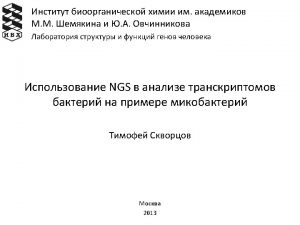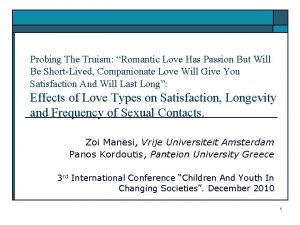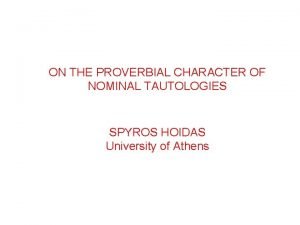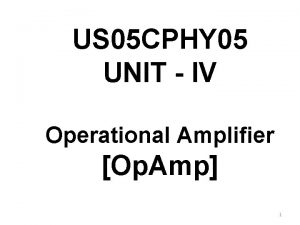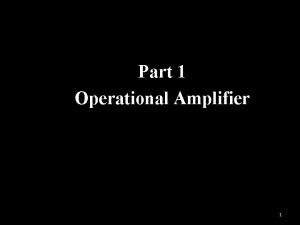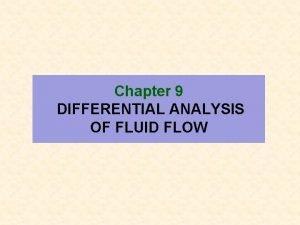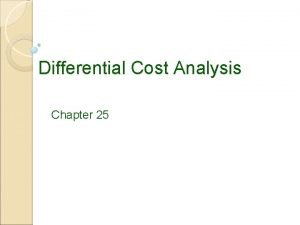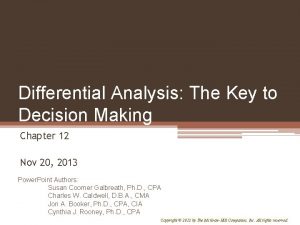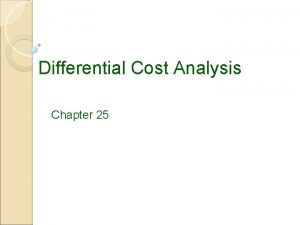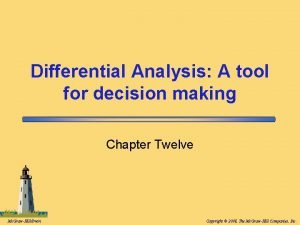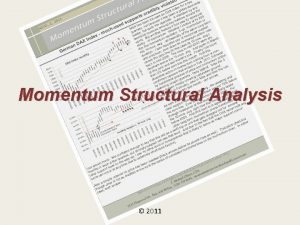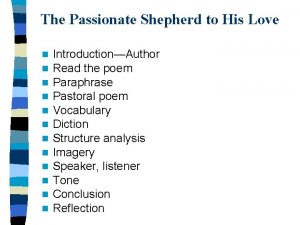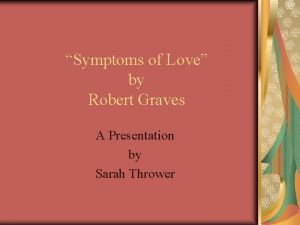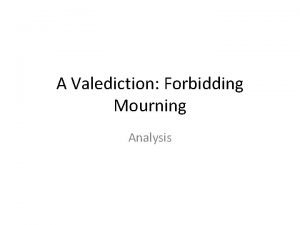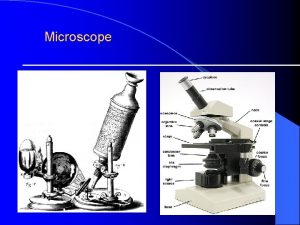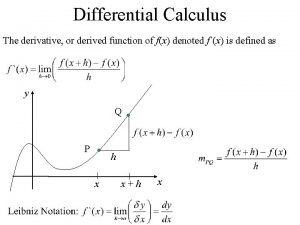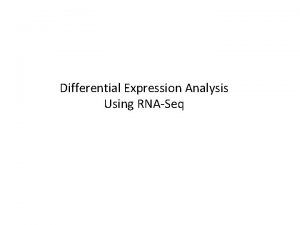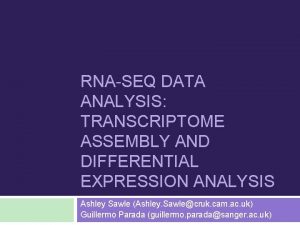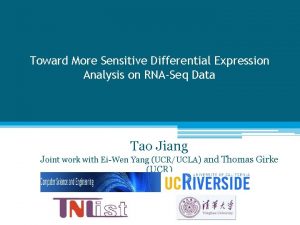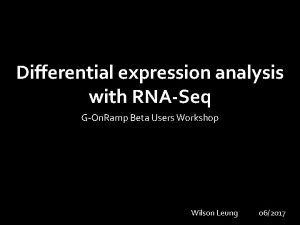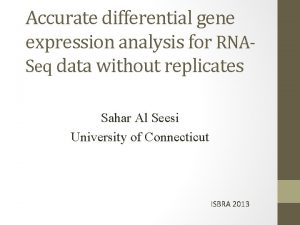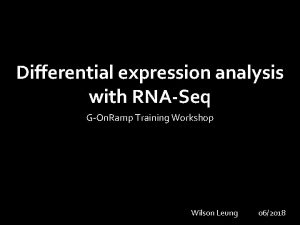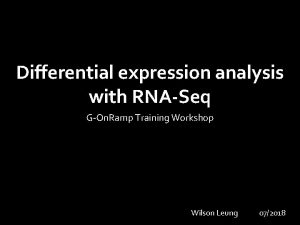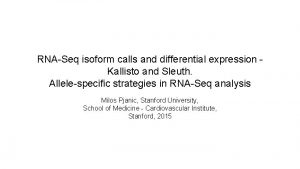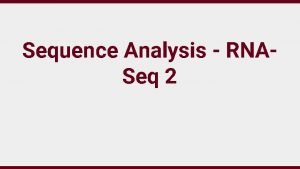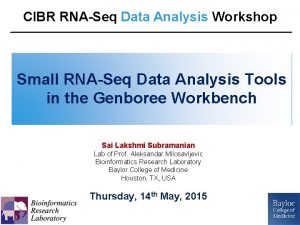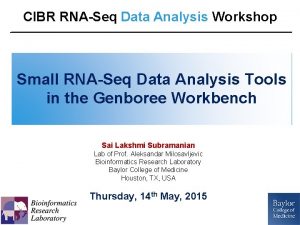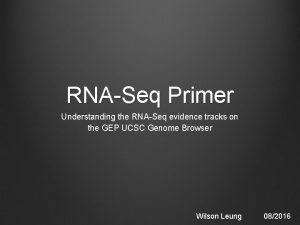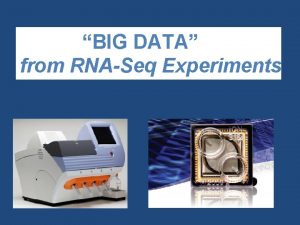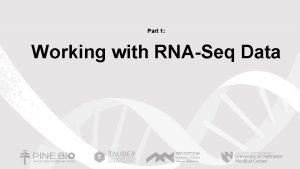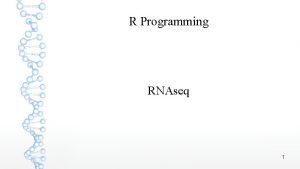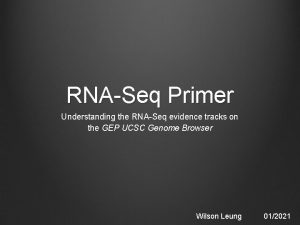RNAseq genelevel analysis and differential expression Michael Love



























































![Looking up help for objects > class(dds) [1] "DESeq. Data. Set" attr(, "package") [1] Looking up help for objects > class(dds) [1] "DESeq. Data. Set" attr(, "package") [1]](https://slidetodoc.com/presentation_image_h2/3d9aa364e2cced7c7197855369afad08/image-60.jpg)

- Slides: 61

RNA-seq gene-level analysis and differential expression Michael Love @mikelove. github. io Dept. of Biostatistics Dept. of Genetics UNC-Chapel Hill ANGUS @ DIBSI June, 2017

Outline 1. Example RNA-seq experiment 2. Statistical analysis of counts 3. Genes and transcripts 4. Theory of shrinkage estimation, why? 5. Testing steps & statistical power 5/19/2021 MI Love: RNA-seq gene analysis 2

Our goal: what is airway transcriptome response to glucocorticoid hormone? four human donors extract m. RNA control airway epithelial cells 5/19/2021 treat with dexamethasone MI Love: RNA-seq gene analysis 3

Glucocorticoid mechanism of action (C) CSLS / University of Tokyo http: //csls-text 3. c. u-tokyo. ac. jp/ 5/19/2021 MI Love: RNA-seq gene analysis 4

Compare gene expression across treatment, within patient-derived cell line c. DNA libraries control ü Visualize differences between samples ü Test for differences in gene expression, one gene at a time ü Visualize differences treated with across all genes dexamethasone 5/19/2021 MI Love: RNA-seq gene analysis 5

Compare gene expression across treatment, within patient-derived cell line PCA plot c. DNA libraries control MA plot "counts plot" treated with dexamethasone 5/19/2021 MI Love: RNA-seq gene analysis 6

2. Statistical analysis of counts • FPKM: fragments per kilobase per million mapped reads • TPM: transcripts per million • FPKM/TPM ∝ gene expression comparable across transcripts and across genes • Counts have extra information: useful for statistical modeling, require proper offsets 5/19/2021 MI Love: RNA-seq gene analysis cumme. Rbund 7

m. RNAs to RNA-seq fragments colors: different genes Kij = (estimated) count of fragments assigned to gene i, sample j is proportional to: SE reads or PE fragments m. RNA transcript 5/19/2021 • • • expression of RNA length of gene sequencing depth RNA extraction & enrichment lib prep factors (RT, PCR) in silico: assignment or alignment error MI Love: RNA-seq gene analysis 8

Sequencing depth sample 1 5/19/2021 sample 2 MI Love: RNA-seq gene analysis 9

Need to have a robust estimator for sequencing depth sample 1: sample 2: gene 1, 2, 3, etc. sample 1: sample 2: (slide from Simon Anders) 5/19/2021 MI Love: RNA-seq gene analysis 10

Median of ratios method simple approach & works well for each gene look at count ratios: sample 1 / sample 2 • • log 2( sample 1 / sample 2 ) in general: create a pseudo-reference-sample (row-wise geometric mean) calculate ratio of each sample to the reference assumes that not ALL genes are DE (differentially expressed) robust to imbalance in up-/down- regulation and large numbers of DE genes 5/19/2021 MI Love: RNA-seq gene analysis 11

Size factors vs normalization factors 5/19/2021 "size factor" "normalization factor" multiplicative per sample & per gene sequencing depth and other factors differ across samples (technical bias: cqn or EDASeq) (gene length: tximport) robustly estimated with median ratio method for sequencing depth can be estimated on top MI Love: RNA-seq gene analysis 12

Transcript lengths sample 1 sample 2 iso. A: 2/3 iso. A: 1/3 iso. B: 2/3 • average transcript length = Σ (isoform percent × effective tx length) • gene counts will be proportional to average transcript length • extreme changes in isoform usage across samples leads to bias if we just look at gene counts • we can use transcript-level quantifiers like Salmon to solve this 5/19/2021 MI Love: RNA-seq gene analysis 13

Variance of counts Consider one gene: 5/19/2021 MI Love: RNA-seq gene analysis 14

Variance of counts Consider one gene: • Binomial sampling distribution • With millions of reads & small proportion for each gene => Poisson sampling distribution 5/19/2021 MI Love: RNA-seq gene analysis 15

Raw counts vs. normalized counts Raw count with mean of 100 Poisson sampling, so SD=10 Raw count mean = 1000 Scaled by 1/10 SD = ? Raw count mean = 10 Scaled by 10 SD = ? 5/19/2021 MI Love: RNA-seq gene analysis 16

Raw counts vs normalized counts raw count for gene i, sample j normalization factor ∝ gene expression statistical inference "for free" edge. R, DESeq 2 can be made to work with extra modeling e. g. limma-voom some distribution 5/19/2021 mean parameter MI Love: RNA-seq gene analysis 17

Biological replicates If the proportions of m. RNA stays exactly constant ("technical replicate") we can expect Poisson dist. 5/19/2021 But realistically, biological variation across sample units is expected MI Love: RNA-seq gene analysis 18

Biological replicates Biological variation for the abundance of a given gene produces "over-dispersion" relative to the Poisson dist. 5/19/2021 Negative Binomial = Poisson with a varying mean MI Love: RNA-seq gene analysis 19

Dispersion parameter raw count for gene i, sample j quantity of interest normalization factor one dispersion per gene variance depends on mean value though 5/19/2021 MI Love: RNA-seq gene analysis 20

Dispersion parameter Poisson part: sampling fragments Extra variation due to biological variance for large counts: (coefficient of variation) alpha = 0. 01 => CV 10% alpha = 0. 25 => CV 50% 5/19/2021 MI Love: RNA-seq gene analysis 21

3. Genes and transcripts • Here, I'm talking about differential gene expression • Another analysis of interest is differential transcript usage within genes • As shown in Cufflinks, tximport, Salmon pubs, accurate gene estimation requires accurate transcript estimation (or else can't gene length or bias right) 5/19/2021 MI Love: RNA-seq gene analysis 22

Differential transcript usage: approaches (list is not complete!) • Exonic bins: DEXSeq • Exonic bins + splice junctions • Dirichlet based approaches: MISO, DRIM-seq • Use transcript abundances to infer Ψ (percent spliced in) for splicing events: SUPPA • Differential transcript expression: – Use posterior uncertainty: Bit. Seq – Use bootstrap variance: Iso. DE, sleuth 5/19/2021 MI Love: RNA-seq gene analysis 23

4. Shrinkage estimation distribution of 1000 darts players' ability: not observed each throws 3 darts: sample variance of the average observed distribution: averages of 3 throws from each of 1000 players shrink the averages towards a center defined by the observed distribution "shrunken" estimates less error overall than individual estimates 5/19/2021 MI Love: RNA-seq gene analysis 24

Shrinkage estimation population distribution dashed = unobserved sampling variance around true ability empirical distribution MLE maximum likelihood estimates the center defines the prior mean shrunken estimates or MAP 5/19/2021 MI Love: RNA-seq gene analysis maximum a posteriori 25

Shrinkage estimation ✗ ✗ ✓ ✓ ✗ 5/19/2021 MI Love: RNA-seq gene analysis 26

Shrinkage estimators in genomics A few examples. Warning: not complete! Lönnstedt and Speed (2002): microarray Smyth (2004): limma for microarray Robinson and Smyth (2007): moderated tests for "digital gene expression" ideas for edge. R • DSS (2012) and DESeq 2 (2014) similar: data-driven strength of prior (optional in edge. R) • • An introduction to shrinkage estimators: Baseball players as example Efron and Morris 1977 "Stein's Paradox in Statistics" 5/19/2021 MI Love: RNA-seq gene analysis 27

Shrinkage and dispersion • Different genes naturally have different scale of biological variability • Over all genes, there will be a distribution of reasonable estimates of dispersion • With small sample size (n=3 -5 replicates per group), we will make very bad estimates of genewise dispersion unless we share information across genes 5/19/2021 MI Love: RNA-seq gene analysis 28

Shrinkage of dispersion for RNA-seq all genes (Pasilla) a subset of genes (Pickrell) 1. Gene estimate = maximum likelihood estimate (MLE) 2. Fitted dispersion trend = the mean of the prior 3. Final estimate = maximum a posteriori (MAP) 5/19/2021 MI Love: RNA-seq gene analysis 29

Shrinkage of fold changes • A t-statistic (signal/noise) can be large for two reasons: – large signal (big difference across groups) – small noise • With DESeq 2, we wanted a way to output reliable estimates of the fold change across groups – fold changes are "noisy" when counts are small, e. g. 4/1 compared to 4, 000/1, 000 – also "noisy" when dispersion is high 5/19/2021 MI Love: RNA-seq gene analysis 30

Shrinkage of fold changes noisy estimates due to low counts large FDR from the statistical model, but we shouldn't trust the estimate itself 5/19/2021 shrinkage is not equal. strong moderation for low information genes: low counts MI Love: RNA-seq gene analysis almost no shrinkage 31

Why shrink fold changes? Split a dataset into two equal parts, compare LFC 5/19/2021 MI Love: RNA-seq gene analysis 32

Why shrink fold changes? Estimates remain reliable even for small sample size and low counts: Mean Squared Error when subsampling to lower seq. depth in silico sub. Seq: Determining Appropriate Sequencing Depth Through Efficient Read Subsampling David G. Robinson and John D. Storey (2014) 5/19/2021 MI Love: RNA-seq gene analysis 33

Why shrink fold changes? Comparison of log fold changes across groups, or experiments. "A new two-step high-throughput approach: 1. gene expression screening of a large number of conditions 2. deep sequencing of the most relevant conditions" G. A. Moyerbrailean et al. "A high-throughput RNA-seq approach to profile transcriptional responses" http: //dx. doi. org/10. 1101/018416 5/19/2021 MI Love: RNA-seq gene analysis 34

Two paths in RNA-seq gene analysis Count matrix Differential expression Transformations and Exploratory Data Analysis (EDA) testing, p-values, FDR DESeq() results() lfc. Shrink() DESeq 2 glm. LRT() top. Tags() edge. R 5/19/2021 clustering, heatmaps, sample-sample distances DESeq 2 edge. R vst(), rlog(), plot. PCA() cpm(), plot. MDS() MI Love: RNA-seq gene analysis 35

Regularized logarithm, "rlog" similar idea as fold change shrinkage, now sample-to-sample fold changes "rlog" sample 2 log 2(x + 1) sample 1 Poisson noise from low counts, when squared a big contribution to Euclidean distance between samples 5/19/2021 MI Love: RNA-seq gene analysis 36

rlog stabilizes variance along the mean "rlog" standard deviation log 2(x + 1) rank( mean ) 5/19/2021 rank( mean ) MI Love: RNA-seq gene analysis corrects systematic dependencies, doesn't force all variances equal. improving distances, clustering, visualizations 37

Also in DESeq 2: VST • Variance stabilizing transformation: calculate the dependence of variance on the mean (using the dispersion trend) • Closed-form expression • vst() is a fast implementation, great for EDA 5/19/2021 MI Love: RNA-seq gene analysis 38

5. Testing steps and power 5/19/2021 MI Love: RNA-seq gene analysis 39

Differences across condition • Describe experiment with formula, e. g. : ~condition • Fit the coefficients once, then extract multiple results tables. per gene the model looks like: log 2 q 1 log 2 q 2 log 2 q 3 log 2 q 4 log 2 q 5 log 2 q 6 5/19/2021 = 1 1 1 0 0 0 1 1 MI Love: RNA-seq gene analysis βIntercept βcondition_B_vs_A βcondition_C_vs_A 40

Differences across condition • Describe experiment with formula, e. g. : ~condition • Fit the coefficients once, then extract multiple results tables. per gene the model looks like: log 2 q 1 log 2 q 2 log 2 q 3 log 2 q 4 log 2 q 5 log 2 q 6 = 1 1 1 0 0 0 1 1 βIntercept βcondition_B_vs_A βcondition_C_vs_A results(dds, contrast=c("condition", "B", "A")) 5/19/2021 MI Love: RNA-seq gene analysis 41

Differences across condition • Describe experiment with formula, e. g. : ~condition • Fit the coefficients once, then extract multiple results tables. per gene the model looks like: log 2 q 1 log 2 q 2 log 2 q 3 log 2 q 4 log 2 q 5 log 2 q 6 = 1 1 1 0 0 0 1 1 βIntercept βcondition_B_vs_A βcondition_C_vs_A results(dds, contrast=c("condition", "C", "A")) 5/19/2021 MI Love: RNA-seq gene analysis 42

Differences across condition • Describe experiment with formula, e. g. : ~condition • Fit the coefficients once, then extract multiple results tables. per gene the model looks like: log 2 q 1 log 2 q 2 log 2 q 3 log 2 q 4 log 2 q 5 log 2 q 6 = 1 1 1 0 0 0 1 1 βIntercept βcondition_B_vs_A βcondition_C_vs_A results(dds, contrast=c("condition", "C", "B")) 5/19/2021 MI Love: RNA-seq gene analysis 43

Controlling for different batches • Using a design formula: ~ batch + condition, adds terms that control for batch differences • If batches are unknown, possible to detect these with other methods: svaseq, RUVSeq 5/19/2021 MI Love: RNA-seq gene analysis 44

Complex designs Want to test: treatment changes for enriched samples over baseline, controlling for individual effects ~individual + enrichment + treatment + enrichment: treatment indiv. 1 1 2 2. . . 5/19/2021 enrich. input IP treat. control treat MI Love: RNA-seq gene analysis 45

DESeq 2 package • Available through Bioconductor since 2013 • Publication: Genome Biology, Dec 2014. main text written with non-statisticians in mind • Builds on good ideas for dispersion estimation and use of GLM from the DSS and edge. R methods • See bioconductor. org/install for installation • Note that the latest Bioconductor packages are only available with latest R version. Bioconductor and R versions are linked 5/19/2021 MI Love: RNA-seq gene analysis 46

DESeq 2 steps we tried to streamline the default pipeline count matrix from e. g. Salmon => tximport 1. size factors (sequencing depth) 2. dispersion (biological variance) 3. Wald test or likelihood ratio test 4. build results table 5. Shrink LFCs DESeq() results() lfc. Shrink() 5/19/2021 MI Love: RNA-seq gene analysis 47

Statistical power • False positive rate (1 - specificity): under the null (no differences), how many called positives? • Precision (1 - false discovery rate): of the positives (called DE), how many are true positives? • Power (sensitivity): under the alternative to the null, how many called positive? 5/19/2021 MI Love: RNA-seq gene analysis 48

Statistical power Why not use a simple t-test on log normalized counts? DESeq 2 t-test 5/19/2021 MI Love: RNA-seq gene analysis 49

Factors influencing power • Range of count – Sequencing depth – Expression – Gene length • Sample size • Dispersion • True fold change 5/19/2021 MI Love: RNA-seq gene analysis 50

Bioc pkg: RNASeq. Power varying the count 5/19/2021 varying the dispersion MI Love: RNA-seq gene analysis 51

log fold change ratio of small p-values Power depends on range of counts mean normalized count By excluding some tests, e. g. genes with mean normalized count < 5, we reduce the penalty from multiple test correction, i. e. we increase experiment-wide power. This threshold is automatically determined (data-driven) by results() 5/19/2021 MI Love: RNA-seq gene analysis 52

Power depends on range of counts quantile of mean of normalized counts • Filter on a statistic which is: – independent of the test statistic under the null – correlated under the alternate hypothesis Bourgon, Gentleman and Huber, PNAS 2010. 5/19/2021 MI Love: RNA-seq gene analysis 53

Independent Hypothesis Weighting Data-driven hypothesis weighting increases detection power in genome-scale multiple testing Nikolaos Ignatiadis, Bernd Klaus, Judith B Zaugg & Wolfgang Huber results(dds, filter. Fun=ihw) 5/19/2021 MI Love: RNA-seq gene analysis 54

Testing against a threshold "We get too many DEGs. . . " null hypothesis: LFC = 0 using 'lfc. Threshold' in results() null hypothesis: fold change is < 2 or > 1/2 "For well-powered experiments, however, a statistical test against the conventional null hypothesis of zero LFC may report genes with statistically significant changes that are so weak in effect strength that they could be considered irrelevant or distracting. " 5/19/2021 MI Love: RNA-seq gene analysis 55

Count model vs linear model • DESeq 2 and edge. R similar approach, similar results – very sensitive, may sometimes underestimate FDR • limma+voom uses a linear model, weights determined by variance over mean – strong control of FDR, may be less sensitive for small sample size – recommended (by me) when number of biological replicates per group grows large (e. g. > 20) 5/19/2021 MI Love: RNA-seq gene analysis 56

Bioconductor help • Vignettes: > browse. Vignettes("DESeq 2") > vignette("DESeq 2") • Type ? then the function name: > ? results • Workflows: bioconductor. org/help/workflows/rnaseq. Gene 5/19/2021 MI Love: RNA-seq gene analysis 57

Bioconductor help results package: DESeq 2 R Documentation Extract results from a DESeq analysis Description: ‘results’ extracts a result table from a DESeq analysis giving base means across samples, log 2 fold changes, standard errors, test statistics, p-values and adjusted p-values; ‘results. Names’ returns the names of the estimated effects (coefficents) of the model; ‘remove. Results’ returns a ‘DESeq. Data. Set’ object with results columns removed. Usage: results(object, contrast, name, lfc. Threshold = 0, alt. Hypothesis = c("greater. Abs", "less. Abs", "greater", "less"), list. Values = c(1, -1), cooks. Cutoff, independent. Filtering = TRUE, alpha = 0. 1, filter, theta, p. Adjust. Method = "BH", format = c("Data. Frame", "GRanges. List"), test, add. MLE = FALSE, tidy = FALSE, parallel = FALSE, BPPARAM = bpparam()). . . Arguments: object: a DESeq. Data. Set, on which one of the following functions has already been called: ‘DESeq’, ‘nbinom. Wald. Test’, or ‘nbinom. LRT’ contrast: this argument specifies what comparison to extract from the ‘object’ to build a results table. one of either: • a character vector with exactly three elements: the name of a factor in the design formula, the name of the numerator level for the fold change, and the name of the denominator level for the fold change (simplest case) 5/19/2021 MI Love: RNA-seq gene analysis 58

Bioconductor help Value: For ‘results’: a ‘DESeq. Results’ object, which is a simple subclass of Data. Frame. This object contains the results columns: ‘base. Mean’, ‘log 2 Fold. Change’, ‘lfc. SE’, ‘stat’, ‘pvalue’ and ‘padj’, and also includes metadata columns of variable information. . . . References: Richard Bourgon, Robert Gentleman, Wolfgang Huber: Independent filtering increases detection power for high-throughput experiments. PNAS (2010), <URL: http: //dx. doi. org/10. 1073/pnas. 0914005107> See Also: ‘DESeq’ Examples: ## Example 1: simple two-group comparison dds <- make. Example. DESeq. Data. Set(m=4). . . 5/19/2021 MI Love: RNA-seq gene analysis 59
![Looking up help for objects classdds 1 DESeq Data Set attr package 1 Looking up help for objects > class(dds) [1] "DESeq. Data. Set" attr(, "package") [1]](https://slidetodoc.com/presentation_image_h2/3d9aa364e2cced7c7197855369afad08/image-60.jpg)
Looking up help for objects > class(dds) [1] "DESeq. Data. Set" attr(, "package") [1] "DESeq 2" > ? DESeq. Data. Set > help(package="DESeq 2", help_type="html") 5/19/2021 MI Love: RNA-seq gene analysis 60

Bioconductor support site All questions about Bioconductor software post to: support. bioconductor. org edit posts voting comment / reply • biological question always provide: • all code, any errors/warnings • session. Info() 5/19/2021 MI Love: RNA-seq gene analysis 61
 Rnaseq illumina
Rnaseq illumina Love love jesus is love god greatest gift lyrics
Love love jesus is love god greatest gift lyrics Quadratic formula
Quadratic formula Vocal music of israel and arabia
Vocal music of israel and arabia The salvation of man is through love and in love
The salvation of man is through love and in love That you must love me and love my dog summary
That you must love me and love my dog summary His love endures forever michael w smith
His love endures forever michael w smith Passionate love vs companionate love
Passionate love vs companionate love Passionate love vs companionate love
Passionate love vs companionate love Love versus in love
Love versus in love Infuatuation
Infuatuation What is infatuation
What is infatuation 2 corinthians 13 4 8
2 corinthians 13 4 8 Companionate love vs consummate love
Companionate love vs consummate love Passionate love vs companionate love
Passionate love vs companionate love Is gift giving a love language
Is gift giving a love language For the sake of beauty
For the sake of beauty When love fails you
When love fails you Oh my love, my darling
Oh my love, my darling Courtly love vs modern love
Courtly love vs modern love Luke connaughton
Luke connaughton Love is love tautology
Love is love tautology Love begets love do you agree
Love begets love do you agree Cphy
Cphy Thermogravimetric analysis principle
Thermogravimetric analysis principle Dta dsc
Dta dsc Double ended ac voltage gain
Double ended ac voltage gain Viscous fluid example
Viscous fluid example Differential cost example
Differential cost example Differential analysis the key to decision making
Differential analysis the key to decision making Differential power analysis kocher
Differential power analysis kocher Signal amplifier
Signal amplifier Dta
Dta Digital differential analysis
Digital differential analysis Differential cost analysis
Differential cost analysis Differential analysis the key to decision making
Differential analysis the key to decision making Regular expression lexical analysis
Regular expression lexical analysis Farewell love poem analysis
Farewell love poem analysis Michael oliver msa
Michael oliver msa Michael craig martin analysis
Michael craig martin analysis Summary of the passionate shepherd to his love
Summary of the passionate shepherd to his love The passionate shepherd to his love imagery
The passionate shepherd to his love imagery The passionate shepherd to his love analysis
The passionate shepherd to his love analysis The passionate shepherd to his love analysis
The passionate shepherd to his love analysis The garden of love annotations
The garden of love annotations Symptoms of true love
Symptoms of true love John agard rainbow
John agard rainbow Me mudder poem
Me mudder poem Love is not all about
Love is not all about Summary of a valediction forbidding mourning
Summary of a valediction forbidding mourning Martyn lowery
Martyn lowery Love's diet analysis
Love's diet analysis Differential media vs selective media
Differential media vs selective media Enterobacter aerogenes gram positive or negative
Enterobacter aerogenes gram positive or negative Difference between differential and selective media
Difference between differential and selective media Partial differential equations examples
Partial differential equations examples Staphylococcus aureus eosin methylene blue agar
Staphylococcus aureus eosin methylene blue agar Displacement to velocity differentiate
Displacement to velocity differentiate Solved problems on differential amplifier
Solved problems on differential amplifier Partial differential equations ppt
Partial differential equations ppt Microbiology bacterial growth
Microbiology bacterial growth Integral manchester encoding
Integral manchester encoding
